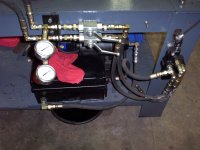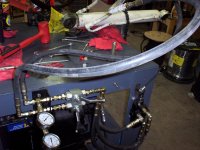SPYDERLK
Super Star Member
- Joined
- Feb 28, 2006
- Messages
- 10,385
- Location
- VA
- Tractor
- JD2010, Kubota3450,2550, Mahindra 7520 w FEL w Skid Steer QC w/Tilt Tatch, & BH, BX1500
Wayne County Hose said:When splitting large diameters, the cylinder rod is not pushing straight out, the wood is trying to force the rod off of the cylinders centerline. The most common repair I see on log splitter hydraulics is a bent rod. All things being equal, or close to it, buy the splitter with the larger diameter rod.
My post was to the 1st of your posts above. Perhaps I misunderstood your meaning. You dont seem to be supporting that post in the latest post, so maybe I did. The second post is on and off the mark; a] it is very important that the cyl body and the rod end float/pivot wrt each other so that the cyl axis and the extending rod can follow a straight line between 2 points, else flexure or misalignment in the assembly will cause a true bending moment, b] as you say, extension of the rod makes that 'straight line' more and more floppy, c] cyl manufacturers would be negligent to make generic pivot end cyls with rods too small to tolerate full extension/floppiness at full rated pressure with end mounts in decent alignment, d] [[[log pop will cause a quick acceleration of the ram, as you say, but that quick motion merely quickens the unobstructed flow of fluid from the small side back to the reservoir - so pressure on that side goes from 0 to 100psi maybe -- but for the sake of discussion, even if it transiently snapped above relief pressure it could not buckle the rod since pressure on that end counters rod extension - - only the seals would suffer]]], e] open tandem center valves such as used on loaders seal off the cyls when centered, so can allow very high pressure on cyls from bounce or push when the valve is centered. Splitter valves are plain open center, and vent both working ports to reservoir when centered - no overpressure allowed here.Wayne County Hose said:Nice try, but swivels have nothing to do with the rod bending. They bend on a splitter because the rod is extended far out of the cylinder housing and more force is placed on the rod than it can handle. So, it bends. Kind of like pressing a 2"x4" piece of lumber against a wall. It doesn't matter what you do to the ends, it will bend in the middle.
The further the rod is extended, the easier it is for a catastrophe. The closer the piston gets to the gland, the easier it is for everything to bend. Same principal as an extension ladder, collapsed, it's very strong. Extend them all the way and they get shaky.
Cylinder manufacturers rarely have any input as to the engineering of the equipment their cylinders are manufactured for.
[[[As for no possibility of pressure higher than relief, you have got to be kidding me. When you have a gnarly piece of wood that builds pressure on the piston end approaching relief, then the wood pops, the piston goes flying forward, exerting all this force on the rod/gland end of the cylinder. I would bet that pressure spikes on the rod/gland end approach double the relief valve pressure.]]]
larry


